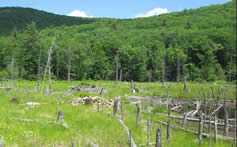
The goal of land conservation is to permanently protect natural or cultural resources. Together with protecting wildlife habitat, conservation lands also provide scenic, recreational and educational areas and preserve community rural character.
Land conservation includes outright ownership (see "fee acquisition," below) and conservation easements. With a conservation plan for wildlife habitats in place, you are ready to start work on some specific conservation projects. Habitat protection is often one of the primary reasons many landowners conserve land. Using the priority areas for wildlife habitat protection identified in your conservation plan, you can start to identify land ownership within those areas. Now is the time to start conversations with those landowners to gauge their level of interest in voluntarily conserving their land for wildlife habitat. Use the step-by-step guide below with your community to strategically protect land for wildlife. Different types of land conservation include:
- Voluntary conservation easements is among the most common land conservation techniques. A conservation easement is a legally binding agreement between a landowner and a conservation organization that limits certain uses of the land in perpetuity. Landowners can donate or sell conservation easements to towns, some government agencies or conservation groups. With a conservation easement, the landowner still owns the land and can continue to use it for activities such as forestry and farming. However no subdivision, commercial development or mining are permitted (the development rights for the land are extinguished). The conservation organization holding the easement is responsible for monitoring the property annually to ensure the terms of the easement are followed.
- Fee acquisition is when the landwner sells or donates full ownership of their land to a conservation organization.
- Other options that are generally less effective and less widely used include deed restrictions and covenants.